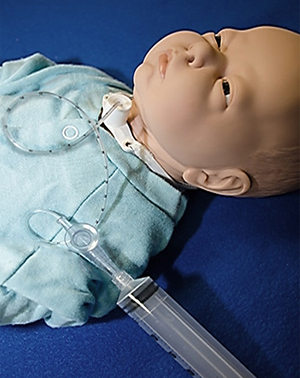Suctioning & Secretions
Making mucus is the body’s way of keeping the airway clean. When mucus builds up in a tracheostomy tube, we suction. That makes breathing easier.
It’s OK to do suctioning whenever it’s needed. Some children require very little suctioning. Other children require more frequent suctioning.
During the first few weeks after a trach is placed, your child may have a large amount of mucus. This is due to the surgery itself and the body’s normal response to the new tube. In many children the amount of mucus should decrease with time. We’ll give you specific instructions before you go home about how often to suction your child.
When to Suction
- You notice changes in your child’s breathing.
- Your child is gurgling or coughing more often.
- Your child’s breathing is “noisy.”
- You see bubbles or mucus coming from the trach opening.
- Your child has a lower oxygen saturation.
- If your child has a ventilator, your peak inspiratory pressure (PIP) is higher than usual.
Types of Suctioning
- Secretions are suctioned at the opening of the trach after the child has coughed them up. This type of suctioning is only used to suction the outside of the trach tube.
- These should never be placed inside the trach itself because it will block your child's airway.
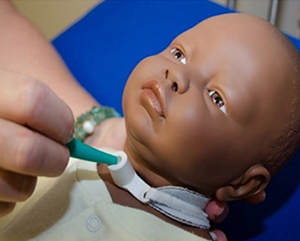
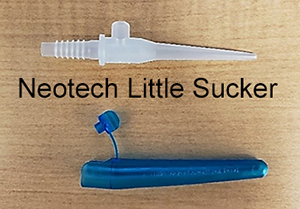
View a video about pre-measured suctioning.
Pre-measured or Deep Suctioning is suction that is measured according to the length of the trach tube. This allows for suctioning the complete length of the the trach tube. The suction depth will differ according to your child's trach size.
You do not want the tip of the suction tube to extend past the end of the tracheostomy tube.
![]() Never suction past the end of the trach tube.
Never suction past the end of the trach tube.
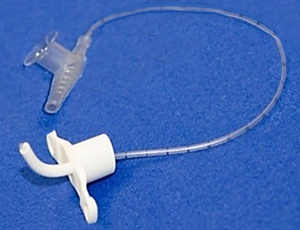
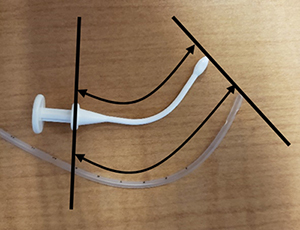
How to Suction
- Suction catheter
- Suction system
- Water
- Saline (optional)
- Non-sterile gloves (optional)
- Under 1 year old - 60 to 80 mm/Hg*
- Over 1 year old - 80 to 100 mm/Hg*
* Check with your healthcare team to determine best suctioning pressure for your child.
- Wash your hands and/or use non-sterile gloves
- Attach suction catheter to suction system (Always use a clean catheter)
Make sure that suction is functioning properly - Insert suction catheter into trach up to pre-determined length (Be sure the catheter doesn't touch any unclean surfaces)
- Cover suction port with thumb and twirl catheter as you remove it from trach
Insert catheter without thumb over port (See photo.)
Place your thumb over the port to suction (See photo.) - Don’t suction for more than 10 seconds
Your child gets less air when you suction. The suction catheter also blocks the trach tube, making it difficult for the child to breathe. - Allow at least 30 seconds between each time you suction. This allows the child enough time to rest and breathe.
- If secretions are thick, suction saline or water up into the catheter by placing tip of catheter into saline or water while applying suction. This will help clean and clear the catheter of secretions.
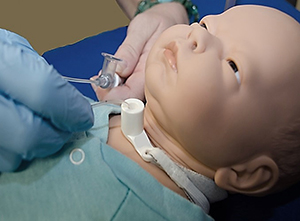
Insert catheter without thumb over port.
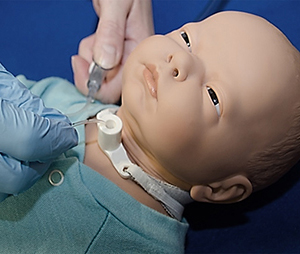
Place your thumb over the port to suction.
When to Clean
It's important to clean and change your canisters and tubing regularly to prevent bacteria from building up and causing an infection.
- Clean suction canister daily
- Clean suction tubing daily
- Change suction canister every week
- Change suction tubing every week
Supplies Needed
- Dish soap
- Hot water
- Clean, dry container
How to Clean
- Wash your hands
- Wash catheter and suction canister inside and out with hot soapy water. Dish soap is ideal. Do not use soaps that contain lotions.
- Rinse well with warm water. It is important that there is no soapy residue left on catheters.
You can use the suction machine to suction warm water through the suction catheter to ensure it is well rinsed. - Air dry. Do not place any heat on catheter to dry as this can cause damage to the catheter.
- Store in a clean, dry container
The suction catheter won't go in
- Tracheostomy is plugged.
- The suction catheter might be too big. Be sure you have the right size suction catheter for child’s tracheostomy.
- If you have the correct size catheter, and it still doesn’t go in, change the tracheostomy.
Suction machine is not working or suctioning properly
View a video about your suction machine not working properly.
- Be sure that the suction machine is plugged in and turned on
- The suction pressure might not be set properly. Test suction pressure by turning machine on and blocking end of the suction tubing. With end blocked, you will be able to read the pressure on the pressure gauge. Use control knob to adjust to desired safe suction pressure
- The suction canister might be too full. Be sure that the canister has been emptied, suction tubing has been changed, and filter has been changed. Use bulb suction or suction catheter attached to 60 mL syringe, if needed.
![]()
Keep your suction machine plugged in when you’re not traveling.
If there’s a power outage, you should have several hours of battery power for suctioning.
If you lose electricity for a long time or your suction machine isn’t working, you can attach a syringe to a suction catheter to suction your child.
